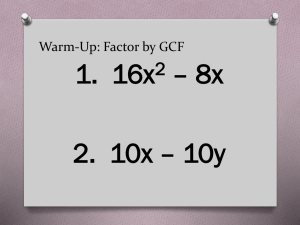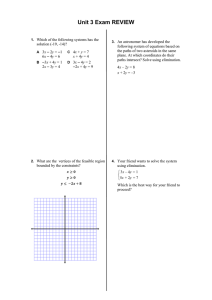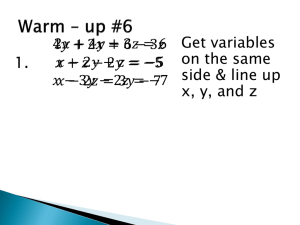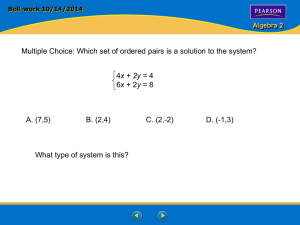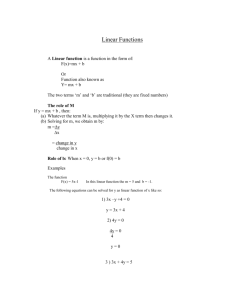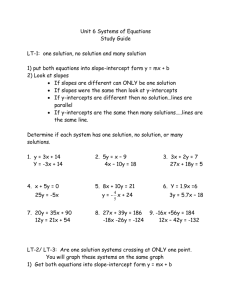Martin Buttle's Presentation
advertisement
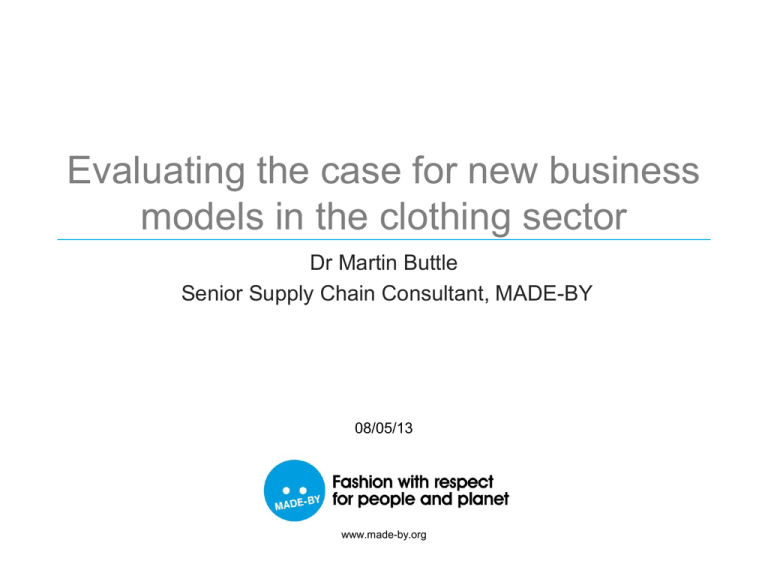
Evaluating the case for new business models in the clothing sector Dr Martin Buttle Senior Supply Chain Consultant, MADE-BY 08/05/13 www.made-by.org Introduction A study of alternative business models in the fashion industry, with an aim to: • Assess their commercial viability for take up by a large scale retailer • Assess their potential to reduce resource impacts, particularly waste, water and carbon UK Waste Footprint Resource Price Index The Business Models Model 1 – Retailers providing repair and upgrading services and repair workshops for their own garments Model 2 - Retailers providing large-scale leasing services (e.g. for baby clothes) Model 3 - Retailers providing large-scale services for one-off hire Model 4 – Retailers offering a reuse section for own-brand garments within their store Model 5 – Peer to peer exchange Model 1: Retailers offering in-store repair services Model 2: Baby Clothes Leasing Model 3: large-scale online hire services Model 4: Buy-back & resale Model 5: peer to peer exchange Methodology: Scope What was included in the study: • IPSOS-Mori data used to gauge consumer demand • Desk based research and interviews • Scenario analysis • Erred on the side of caution in building the conservative scenarios • Where possible, validation of assumptions applied What was excluded from the study: • Impact on existing small scale business providers • Net impact on sales of products under retailers existing models • Industry wide implications Methodology: Financial Analysis • A financial model created for each business model • Commercial viability measured against the following key performance indicators: - 2 year payback on capital invested - a return on capital of 15% - a positive Net Present Value of cash flow • Scenarios created for each model (except Model 3) - a conservative (or realistic) scenario - a tipping point scenario Methodology: Resource Impacts Calculations: • Cotton t-shirt used as basis to calculate resource savings • Resource saving of a garment saved or displaced based on weight. 0.33 kg/adult garment & 0.07kg / baby garment Carbon and water saving based on displacement effect applied to each model: • Carbon - 21 tonnes of CO2e saved per garment displaced • Water - 4695 litres of water saved per garment displaced Waste savings is a combination of garments displaced and saved from going to landfill Displacement effect varied across models Summary: Financial Performance Scenario 1: Conservative Assumptions Scenario 1 Model 1 Model 2 Repair Workshop Years Financially viable Payback time (Target 2Y) ROC (target:>15%) NPV, £K (target:>0) Gross Profit Margin Operating Profit Margin EBITDA Model 3 Baby Clothes Leasing Model 4 Formal Clothing hire Model 5 Buy-back & resale Peer to peer 5Y 10Y 5Y 10Y 5Y 10Y 5Y 10Y 5Y 10Y No n/a n/a n/a 10.13% -38.74% -6.95% No n/a n/a No 4.9 years n/a n/a 55.11% 0.63% 20.08% Maybe 4.9 years 140.82% £314k 54.66% 11.63% 28.55% Yes 2.9 years 36% £149 67.04% 10.69% 45.34% Yes 2.9 years 224.02% £624k 68.19% 16.00% 49.19% Yes 2.3 years 259% £556 58% 28% 28% Yes 2.3 years 1158% £1763k 60% 39% 39% No n/a n/a n/a n/a n/a n/a No n/a n/a (£1,411k) -19% n/a n/a (-1071) 15.66% -9.88% 5.46% Scenario 2: Tipping Point Scenario 2 Model 1 Model 2 Repair Workshop Years Model 3 Baby Clothes Leasing Model 4 Formal Clothing hire Model 5 (Scenario 3) Buy-back & resale Peer to peer 5Y 10Y 5Y 10Y 5Y 10Y 5Y 10Y 5Y 10Y ROC (target:>15%) No n/a 2.20% No 5.8 years 194.29% NPV, £K (target:>0) n/a (£1,062K) Gross Profit Margin 43.79% 2.25% 20.65% 46.99% 24.49% 33.37% Maybe 2.7 years 131% £501 64% 20% 32% Yes 2.7 years 515% £1,634k 64% 29% 40% Yes 2.9 years 36% £149 67% 11% 45% Yes 2.9 years 224.02% £624k 68% 16% 49% Yes 2.2 years 281% £630 23% 12% 12% Yes 2.2 years 1278% £1,922k 25% 17% 17% No n/a n/a £661 26% -69% -69% Maybe 7 232% £803k 34% 19% 19% Financially viable Payback time (Target 2Y) Operating Profit Margin EBITDA Summary: Financial Performance Scenario 1: Conservative Assumptions Scenario 1 Years Financially viable Payback time (Target 2Y) ROC (target:>15%) NPV, £K (target:>0) Gross Profit Margin Operating Profit Margin EBITDA Model 1 Model 2 Model 3 Model 4 Model 5 Repair Workshop Baby Clothes Leasing Formal Clothing hire Buy-back & resale Peer to peer 5Y 10Y 5Y 10Y 5Y 10Y 5Y 10Y 5Y 10Y No n/a n/a n/a 10.13% -38.74% -6.95% No n/a n/a No 4.9 years n/a n/a 55.11% 0.63% 20.08% Maybe 4.9 years 140.82% £314k 54.66% 11.63% 28.55% Yes 2.9 years 36% £149 67.04% 10.69% 45.34% Yes 2.9 years 224.02% £624k 68.19% 16.00% 49.19% Yes 2.3 years 259% £556 58% 28% 28% Yes 2.3 years 1158% £1763k 60% 39% 39% No n/a n/a n/a n/a n/a n/a No n/a n/a (£1,411k) -19% n/a n/a (-1071) 15.66% -9.88% 5.46% Scenario 2: Tipping Point Scenario 2 Years Financially viable Payback time (Target 2Y) Model 1 Model 2 Model 3 Model 4 Model 5 (Scenario 3) Repair Workshop Baby Clothes Leasing Formal Clothing hire Buy-back & resale Peer to peer 5Y 10Y No n/a 2.20% No 5.8 years 194.29% NPV, £K (target:>0) n/a (£1,062K) Gross Profit Margin 43.79% 2.25% 20.65% 46.99% 24.49% 33.37% ROC (target:>15%) Operating Profit Margin EBITDA 5Y Maybe 2.7 years 131% £501 64% 20% 32% 10Y 5Y 10Y 5Y 10Y 5Y 10Y Yes 2.7 years 515% £1,634k 64% 29% 40% Yes 2.9 years 36% £149 67% 11% 45% Yes 2.9 years 224.02% £624k 68% 16% 49% Yes 2.2 years 281% £630 23% 12% 12% Yes 2.2 years 1278% £1,922k 25% 17% 17% No n/a n/a £661 26% -69% -69% Maybe 7 232% £803k 34% 19% 19% Summary: Financial Performance Scenario 1: Conservative Assumptions Scenario 1 Years Financially viable Payback time (Target 2Y) ROC (target:>15%) NPV, £K (target:>0) Gross Profit Margin Operating Profit Margin EBITDA Model 1 Model 2 Model 3 Model 4 Model 5 Repair Workshop Baby Clothes Leasing Formal Clothing hire Buy-back & resale Peer to peer 5Y 10Y 5Y 10Y 5Y 10Y 5Y 10Y 5Y 10Y No n/a n/a n/a 10.13% -38.74% -6.95% No n/a n/a No 4.9 years n/a n/a 55.11% 0.63% 20.08% Maybe 4.9 years 140.82% £314k 54.66% 11.63% 28.55% Yes 2.9 years 36% £149 67.04% 10.69% 45.34% Yes 2.9 years 224.02% £624k 68.19% 16.00% 49.19% Yes 2.3 years 259% £556 58% 28% 28% Yes 2.3 years 1158% £1763k 60% 39% 39% No n/a n/a n/a n/a n/a n/a No n/a n/a (£1,411k) -19% n/a n/a (-1071) 15.66% -9.88% 5.46% Scenario 2: Tipping Point Scenario 2 Years Financially viable Payback time (Target 2Y) Model 1 Model 2 Model 3 Model 4 Model 5 (Scenario 3) Repair Workshop Baby Clothes Leasing Formal Clothing hire Buy-back & resale Peer to peer 5Y 10Y No n/a 2.20% No 5.8 years 194.29% NPV, £K (target:>0) n/a (£1,062K) Gross Profit Margin 43.79% 2.25% 20.65% 46.99% 24.49% 33.37% ROC (target:>15%) Operating Profit Margin EBITDA 5Y Maybe 2.7 years 131% £501 64% 20% 32% 10Y 5Y 10Y 5Y 10Y 5Y 10Y Yes 2.7 years 515% £1,634k 64% 29% 40% Yes 2.9 years 36% £149 67% 11% 45% Yes 2.9 years 224.02% £624k 68% 16% 49% Yes 2.2 years 281% £630 23% 12% 12% Yes 2.2 years 1278% £1,922k 25% 17% 17% No n/a n/a £661 26% -69% -69% Maybe 7 232% £803k 34% 19% 19% Summary: Financial Performance Scenario 1: Conservative Assumptions Scenario 1 Model 1 Model 2 Repair Workshop Years Financially viable Payback time (Target 2Y) ROC (target:>15%) NPV, £K (target:>0) Gross Profit Margin Operating Profit Margin EBITDA Model 3 Baby Clothes Leasing Model 4 Formal Clothing hire Model 5 Buy-back & resale Peer to peer 5Y 10Y 5Y 10Y 5Y 10Y 5Y 10Y 5Y 10Y No n/a n/a n/a 10.13% -38.74% -6.95% No n/a n/a No 4.9 years n/a n/a 55.11% 0.63% 20.08% Maybe 4.9 years 140.82% £314k 54.66% 11.63% 28.55% Yes 2.9 years 36% £149 67.04% 10.69% 45.34% Yes 2.9 years 224.02% £624k 68.19% 16.00% 49.19% Yes 2.3 years 259% £556 58% 28% 28% Yes 2.3 years 1158% £1763k 60% 39% 39% No n/a n/a n/a n/a n/a n/a No n/a n/a (£1,411k) -19% n/a n/a (-1071) 15.66% -9.88% 5.46% Scenario 2: Tipping Point Scenario 2 Model 1 Model 2 Repair Workshop Years Model 3 Baby Clothes Leasing Model 4 Formal Clothing hire Model 5 (Scenario 3) Buy-back & resale Peer to peer 5Y 10Y 5Y 10Y 5Y 10Y 5Y 10Y 5Y 10Y ROC (target:>15%) No n/a 2.20% No 5.8 years 194.29% NPV, £K (target:>0) n/a (£1,062K) Gross Profit Margin 43.79% 2.25% 20.65% 46.99% 24.49% 33.37% Maybe 2.7 years 131% £501 64% 20% 32% Yes 2.7 years 515% £1,634k 64% 29% 40% Yes 2.9 years 36% £149 67% 11% 45% Yes 2.9 years 224.02% £624k 68% 16% 49% Yes 2.2 years 281% £630 23% 12% 12% Yes 2.2 years 1278% £1,922k 25% 17% 17% No n/a n/a £661 26% -69% -69% Maybe 7 232% £803k 34% 19% 19% Financially viable Payback time (Target 2Y) Operating Profit Margin EBITDA Summary: Financial Performance Scenario 1: Conservative Assumptions Scenario 1 Years Financially viable Payback time (Target 2Y) ROC (target:>15%) NPV, £K (target:>0) Gross Profit Margin Operating Profit Margin EBITDA Model 1 Model 2 Model 3 Model 4 Model 5 Repair Workshop Baby Clothes Leasing Formal Clothing hire Buy-back & resale Peer to peer 5Y 10Y 5Y 10Y 5Y 10Y 5Y 10Y 5Y 10Y No n/a n/a n/a 10.13% -38.74% -6.95% No n/a n/a No 4.9 years n/a n/a 55.11% 0.63% 20.08% Maybe 4.9 years 140.82% £314k 54.66% 11.63% 28.55% Yes 2.9 years 36% £149 67.04% 10.69% 45.34% Yes 2.9 years 224.02% £624k 68.19% 16.00% 49.19% Yes 2.3 years 259% £556 58% 28% 28% Yes 2.3 years 1158% £1763k 60% 39% 39% No n/a n/a n/a n/a n/a n/a No n/a n/a (£1,411k) -19% n/a n/a (-1071) 15.66% -9.88% 5.46% Scenario 2: Tipping Point Scenario 2 Years Model 1 Model 2 Model 3 Model 4 Model 5 (Scenario 3) Repair Workshop Baby Clothes Leasing Formal Clothing hire Buy-back & resale Peer to peer 5Y 10Y 5Y 10Y 5Y 10Y 5Y 10Y 5Y 10Y ROC (target:>15%) No n/a 2.20% No 5.8 years 194.29% NPV, £K (target:>0) n/a (£1,062K) Gross Profit Margin 43.79% 2.25% 20.65% 46.99% 24.49% 33.37% Maybe 2.7 years 131% £501 64% 20% 32% Yes 2.7 years 515% £1,634k 64% 29% 40% Yes 2.9 years 36% £149 67% 11% 45% Yes 2.9 years 224.02% £624k 68% 16% 49% Yes 2.2 years 281% £630 23% 12% 12% Yes 2.2 years 1278% £1,922k 25% 17% 17% No n/a n/a £661 26% -69% -69% Maybe 7 232% £803k 34% 19% 19% Financially viable Payback time (Target 2Y) Operating Profit Margin EBITDA Summary: Resource Impacts Scenario 1: Conservative Assumptions Scenario 1 Model 1 Repair Workshop 5Y 10Y Model 2 Baby Clothes Leasing 5Y 10Y Model 3 Formal Clothing hire 5Y 10Y Model 4 Buy-back & resale 5Y 10Y Model 5 Peer to peer 5Y 10Y Not Not Not Resource Impact overall Acceptable Good Good Good Acceptable Acceptable Acceptable Good Acceptable Acceptable No of Garments 419,787 1,534,630 3,455,318 8,829,023 153,635 327,245 570,910 1,643,471 22,601 106,973 Garments saved in weight* 137 502 242 618 38 82 188 542 7 35 Carbon saved* 778 2,844 3,211 8,243 316 681 476 1,386 78 371 Water Saved** 174 636 718 1,843 71 152 106 310 18 83 Scenario 2: Tipping Point Scenario 2 Model 1 Model 2 Model 3 Model 4 Model 5 (Scenario 3) Repair Workshop Baby Clothes Leasing Formal Clothing hire Buy-back & resale Peer to peer 5Y 10Y 5Y 10Y 5Y 10Y 5Y 10Y 5Y 10Y Not Not Resource Impact overall Acceptable Good Acceptable Good acceptable acceptable Acceptable Good Acceptable Good No of Garments 684,283 2,501,558 3,673,771 9,252,277 153,635 327,245 1,427,276 4,108,677 303,180 3,212,150 Garments saved in weight 224 817 257 648 38 82 470 1,354 100 1,060 Carbon saved 1,290 4,716 3,371 8,554 316 681 1,189 3,466 1,051 11,130 Water Saved 288 1,054 754 1,912 71 152 266 775 235 2,488 Summary: Resource Impacts Scenario 1: Conservative Assumptions Scenario 1 Model 1 Repair Workshop 5Y 10Y Model 2 Baby Clothes Leasing 5Y 10Y Model 3 Formal Clothing hire 5Y 10Y Model 4 Buy-back & resale 5Y 10Y Model 5 Peer to peer 5Y 10Y Not Not Not Resource Impact overall Acceptable Good Good Good Acceptable Acceptable Acceptable Good Acceptable Acceptable No of Garments 419,787 1,534,630 3,455,318 8,829,023 153,635 327,245 570,910 1,643,471 22,601 106,973 Garments saved in weight* 137 502 242 618 38 82 188 542 7 35 Carbon saved* 778 2,844 3,211 8,243 316 681 476 1,386 78 371 Water Saved** 174 636 718 1,843 71 152 106 310 18 83 Scenario 2: Tipping Point Scenario 2 Model 1 Model 2 Repair Workshop 5Y 10Y Model 3 Baby Clothes Leasing 5Y 10Y Model 4 Formal Clothing hire 5Y 10Y Model 5 (Scenario 3) Buy-back & resale 5Y 10Y Peer to peer 5Y 10Y Not Not Resource Impact overall Acceptable Good Acceptable Good acceptable acceptable Acceptable Good Acceptable Good No of Garments 684,283 2,501,558 3,673,771 9,252,277 153,635 327,245 1,427,276 4,108,677 303,180 3,212,150 Garments saved in weight 224 817 257 648 38 82 470 1,354 100 1,060 Carbon saved 1,290 4,716 3,371 8,554 316 681 1,189 3,466 1,051 11,130 Water Saved 288 1,054 754 1,912 71 152 266 775 235 2,488 Summary: Resource Impacts Scenario 1: Conservative Assumptions Scenario 1 Model 1 Repair Workshop 5Y 10Y Model 2 Baby Clothes Leasing 5Y 10Y Model 3 Formal Clothing hire 5Y 10Y Model 4 Buy-back & resale 5Y 10Y Model 5 Peer to peer 5Y 10Y Not Not Not Resource Impact overall Acceptable Good Good Good Acceptable Acceptable Acceptable Good Acceptable Acceptable No of Garments 419,787 1,534,630 3,455,318 8,829,023 153,635 327,245 570,910 1,643,471 22,601 106,973 Garments saved in weight* 137 502 242 618 38 82 188 542 7 35 Carbon saved* 778 2,844 3,211 8,243 316 681 476 1,386 78 371 Water Saved** 174 636 718 1,843 71 152 106 310 18 83 Scenario 2: Tipping Point Scenario 2 Model 1 Model 2 Repair Workshop 5Y 10Y Model 3 Baby Clothes Leasing 5Y 10Y Model 4 Formal Clothing hire 5Y 10Y Model 5 (Scenario 3) Buy-back & resale 5Y 10Y Peer to peer 5Y 10Y Not Not Resource Impact overall Acceptable Good Acceptable Good acceptable acceptable Acceptable Good Acceptable Good No of Garments 684,283 2,501,558 3,673,771 9,252,277 153,635 327,245 1,427,276 4,108,677 303,180 3,212,150 Garments saved in weight 224 817 257 648 38 82 470 1,354 100 1,060 Carbon saved 1,290 4,716 3,371 8,554 316 681 1,189 3,466 1,051 11,130 Water Saved 288 1,054 754 1,912 71 152 266 775 235 2,488 Summary: Resource Impacts Scenario 1: Conservative Assumptions Scenario 1 Model 1 Repair Workshop 5Y 10Y Model 2 Baby Clothes Leasing 5Y 10Y Model 3 Formal Clothing hire 5Y 10Y Model 4 Buy-back & resale 5Y 10Y Model 5 Peer to peer 5Y 10Y Not Not Not Resource Impact overall Acceptable Good Good Good Acceptable Acceptable Acceptable Good Acceptable Acceptable No of Garments 419,787 1,534,630 3,455,318 8,829,023 153,635 327,245 570,910 1,643,471 22,601 106,973 Garments saved in weight* 137 502 242 618 38 82 188 542 7 35 Carbon saved* 778 2,844 3,211 8,243 316 681 476 1,386 78 371 Water Saved** 174 636 718 1,843 71 152 106 310 18 83 Scenario 2: Tipping Point Scenario 2 Model 1 Model 2 Repair Workshop 5Y 10Y Model 3 Baby Clothes Leasing 5Y 10Y Model 4 Formal Clothing hire 5Y 10Y Model 5 (Scenario 3) Buy-back & resale 5Y 10Y Peer to peer 5Y 10Y Not Not Resource Impact overall Acceptable Good Acceptable Good acceptable acceptable Acceptable Good Acceptable Good No of Garments 684,283 2,501,558 3,673,771 9,252,277 153,635 327,245 1,427,276 4,108,677 303,180 3,212,150 Garments saved in weight 224 817 257 648 38 82 470 1,354 100 1,060 Carbon saved 1,290 4,716 3,371 8,554 316 681 1,189 3,466 1,051 11,130 Water Saved 288 1,054 754 1,912 71 152 266 775 235 2,488 Model 4 – reuse & restyling The business model: • A retailer provides an incentive for consumers to return used garments • A roll out of stores acting as collection points • A select number flagship stores carry a ‘pre-used’ collection, consisting of reused and restyled garments. Income generation: dependent on number & quality of garments collected, falling into three categories • Recycle (85%) – not sufficient quality for reuse. Income of £0.6 per kilogram • Resale (15%)– highest quality. Retail sales price of £30 • Restyle (2.5%) – repair required before reuse. Retail sales price of £30 Key Cost base: • • • • Discount voucher Logistics Staff costs – picking & packing, restyling Warehousing/retail space cost Model 4 – reuse & restyling Two scenarios created Scenario 1 Scenario 2 1,000/year 2,500/year By end of year 5 5 11 By end of year 10 6 14 re-sold & restyled garments only all garments £500 per collection point None Number of garments collected per collection point Number of retail outlets: 15% discount voucher issued Staff training cost Model 4: Financial Outcome Model 4: Project Financial Appraisal (£1,000's) Scenario 1 Scenario 2 Timeframe 5 years 10 years 5 years 10 years Funds needed £312 £312 £302 £302 NPV £556 £1763k £630 £1,922k Payback 2.3 years 2.3 years 2.2 years 2.2 years Return on Capital 259% 1158% 281% 1278% Model 4: Profitability Performance Summary Per £ of revenue Scenario 1 Scenario 2 Timeframe Gross profit margin 5 years 10 years 5 years 10 years 58% 60% 23% 25% Per sq footage Operating EBITDA Profit Margin 28% 39% 12% 17% 28% 39% 12% 17% Factors that contribute to the viability of this model: • low set up and running costs • low initial funding required Gross profit Operating profit* £250 £312 £108 £136 £119 £202 £56 £91 Model 4: Resource Impacts Garments saved: for every garment collected, 0.7 of a garment is saved from going to waste Garments displaced: for every garment re-sold, including re-styled garments, 0.6 of a garment is displaced Model 4 Appraisal - Resource Impact Scenario 1 # of Timeframe garments saved*** 5 years 10 years 570,910 1,643,471 Garments saved in weight* 188 542 Scenario 2 # of Garments Carbon Water Carbon Water garments saved in Saved* saved** Saved* saved** saved*** weight* 476 1,386 106 310 1,427,276 4,108,677 470 1,354 1,189 3,466 266 775 *weight in tonnes ** in cubic metres ***includes garments displaced • Scenario 1 - generates acceptable level of resource savings • Scenario 2 - higher volume of clothing collection/sale leads to a good level of resource savings Thank You MADE BY UK 3-4 Bywell Place London. W1T 3DN United Kingdom tel: +44 (0)20 7636 3910 fax: +44 (0)20 7323 0337 infouk@made-by.org MADE BY Benelux Prins Hendrikkade 25 1012 TM Amsterdam The Netherlands tel: +31 (0)20 5230666 fax: +31 (0)20 6266132 info@made-by.org MADE BY Germany Königsallee 61 40215 Düsseldorf Germany tel: +49 (0)211 3878 9054 infogermany@made-by.org

